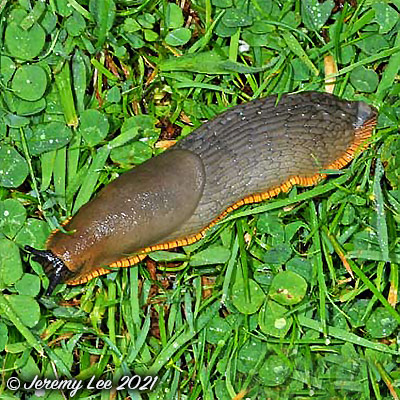
 |
|
Scientific Classifications explained » Amphibians » Ants » Aphids » Bees » Beetles » Birds » Bugs » Butterflies » Caterpillars » Damselflies » Dragonflies » Earwigs » Flies » Frog/Leafhoppers » Fungi » Galls » Grasshoppers » Harvestmen » Hoverflies » Lacewings » Ladybirds » Leaf Mines » Lichens » Mammals » Millipedes » Mosses » Moths » Sawflies » Slugs » Snails » Spiders » Trees & Shrubs » Wasps » Wild Flowers » Woodlice » Postboxes |
UK Nature > Slugs > Arion ater

Scientific Name: Arion ater Common Name: Large Black Slug Arion ater, or the Large Black Slug, as it is more commonly kmown, measures up to about 20cm in length when fully extended, but more usually 10-15cm. Colour ranges from jet black, through chestnut and orange to pale grey and creamy white. Brown and cream forms always have an orange fringe to the sole (see photograph above). There is no keel on the back, but the body is covered with elongated tubercles. When disturbed, the slug contracts into a small hemispherical position and often sways from side to side. Its mucus is extremely sticky. An omnivorous species, eating carrion and dung as well as vegetable matter. It prefers rotting vegetation to living plants and consequently rarely does much harm in the garden. Largely nocturnal, but large numbers have been seen on freshly mown roadside verges feeding on the grass after daytime rain. Clusters of their pearly-white spherical eggs, about 5mm in diameter, are often dug up in the garden and compost heaps. Common throughout the UK. |
|

https://www.uknature.co.uk is a website dedicated to showing the immense diversity of UK nature and wildlife. Our vast range of habitats, from lowland arable to snow covered mountains, from storm-ravaged coastlines to peaceful inland freshwater lakes and rivers, from dry, sandy heaths to deciduous and coniferous forests, all these habitats contribute to the abundance of UK nature. We have wild birds in huge numbers either residing or visiting our shores (597 recorded species as at July 2013) and we must also not forget the humble back garden with its grass lawns, flower beds filled with nectar rich flowers, shrubs and trees, all designed to attract huge numbers of insects such as bees, moths, butterflies and hoverflies; and finally the small ponds which provide safe havens for frogs, toads, newts and even slow worms and grass snakes. www.uknature.co.uk is the showcase for my personal passion, photographing uknature in all its glory. I sincerely hope you all enjoy the fruits of my labours. This site and all images contained therein is © Jeremy Lee 2004 - 2025. All Rights Reserved. Site design by Jeremy Lee. Site development & IT Support by Stuart Lee. |